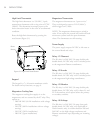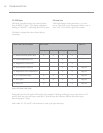
OVEN SYSTEMS
35
Relay - K7 Magnetron Cooling Fan
The K7 relay is a 240 VAC, 30 amp, double-pole,
double-throw, 24 VDC relay coil. It switches power
to the magnetron cooling fans when the magnetron
filaments are actuated. Power is switched off after 4
minutes, 15 seconds.
NOTE: The 4:15 timer starts over each time the
magnetron filaments are actuated.
Relay - K8 Stirrer Motor
The K8 relay is a 240 VAC, 30 amp, double-pole,
double-throw, 24 VDC relay coil. It switches power
to the stirrer motor.
RTD
The RTD measures the temperature of the heater
element. If the display reads “999°F/C”, the RTD
is open, resulting in an F7 fault. See page 43 for
troubleshooting.
Smart Card Reader
The smart card reader allows the oven operator to
load a menu/software updates from a smart card. A
menu that already exists in the oven can also be
saved to a smart card. For instructions, see page 17.
Solid State Relay - K4/K5 Heater
The solid state relay is a 240 VAC, dual 40-amp
relay. K4 (right) switches power to heater 1. K5
(left) switches power to heater 2.
Speaker
The speaker provides audible feedback to the oven
operator whenever a key is pressed or a task (such
as a cook cycle) is completed, etc.
USB Port
The USB port allows the oven operator to load a
menu/software updates from a USB drive. A menu
that already exists in the oven can also be saved to a
USB drive. For instructions, see page 17.
Voltage Sensor
For North America oven models, the oven will
detect 208 or 240 incoming voltage.
The initial voltage selection is typically completed
before the oven is used by the customer. However,
if incoming voltage for the store is different than
the preset voltage, the operator will be required to
select either 208 or 240 after pressing the On/Off
key to turn on the oven. The correct voltage will be
enlarged on the screen, identifying which option to
select.
Wire Harness
The wire harness distributes power to the oven’s
electrical components. See page 51 for a schematic.
Troubleshooting
Potentially, any fault may occur in relation to the
control system. See section “Fault Code
Troubleshooting,” pages 39-44.
Potentially, any one of the issues diagnosed in the
section “Non-Fault Code Troubleshooting” may
occur in relation to the control system. See section
“Non-Fault Code Troubleshooting,” pages 45-49.


















